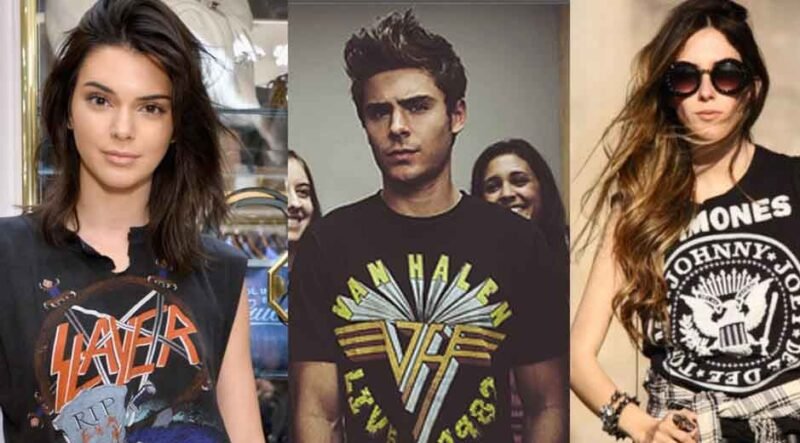Band tees are everywhere — on concertgoers, streetwear fans, and even high-fashion runways. At first glance, they may seem like just simple pieces of merchandise: cotton shirts printed with a band’s logo or album art. But the reality is much deeper. Your favorite band tee is often a wearable piece of cultural history, a personal statement, and a form of art that has evolved significantly over time. Understanding why these tees matter can give you a new appreciation for the shirt hanging in your closet.
The History of Band Tees: More Than Just Merch
The band t-shirt’s story starts in the 1960s and 70s, when rock and roll was surging in popularity. Bands began selling tees as merchandise at concerts, offering fans a way to show their loyalty. These early tees were often simple — basic cotton shirts with a band’s name or a tour date printed on them. They were practical, yes, but also revolutionary. They gave fans a way to carry a piece of the concert experience with them.
As music genres diversified, so did band tees. Punk rock bands of the late 70s and early 80s adopted tees as badges of rebellion. Their designs often featured stark, DIY-style graphics that matched the raw energy of their music. Over time, band tees moved beyond concert halls and became integrated into everyday fashion. By the 1990s, they were worn not only by music fans but also by celebrities and designers, helping to cement their place as cultural symbols.
The Stories Behind the Designs
Every band tee tells a story. Sometimes it’s about the band’s identity, sometimes about a particular album, and other times about a memorable tour. The artwork you see on these shirts is often as carefully crafted as the music itself.
Album covers are a common inspiration. Consider the iconic “Dark Side of the Moon” prism from Pink Floyd or the lightning bolt on David Bowie’s Aladdin Sane tee. These images aren’t just decorative; they encapsulate the spirit of the music and the era. Band logos, such as the Rolling Stones’ lips and tongue, are instantly recognizable symbols that have become part of global pop culture.
Behind many of these designs are artists who have become legends in their own right. Graphic designers, illustrators, and photographers collaborate with bands to create tees that resonate with fans on multiple levels. When you wear a band tee, you’re often wearing a piece of this creative collaboration.
Band Tees as Cultural Symbols
More than just merchandise, band tees have become powerful cultural symbols. Wearing one is a way to signal your identity, your tastes, and sometimes your values. A band tee can say “I was there” or “I’m part of this scene” without you ever having to say a word.
In various subcultures, band tees have different meanings. For punk fans, they might symbolize defiance and nonconformity. For metalheads, they’re a badge of loyalty and toughness. For indie rock fans, they might signal an appreciation for the underground or the obscure. These layers of meaning give band tees a rich cultural significance.
Fashion has also embraced band tees. High-end designers have incorporated them into collections, mixing vintage band shirts with luxury garments. Streetwear brands feature band tee-inspired designs, making the style accessible to a broader audience. This crossover between music and fashion highlights the versatility and staying power of the band tee.
The Collectibility and Value of Vintage Band Tees
Not all band tees are created equal. Some become prized collector’s items, fetching hundreds or even thousands of dollars. Why? Several factors contribute to a tee’s collectibility.
Age is one. Vintage tees from legendary tours or iconic bands are rare and often difficult to find in good condition. Authenticity matters too. Original prints and tags distinguish true vintage shirts from reissues or fakes.
The story behind the tee can add value. A shirt from a historic tour or one worn by a band member is highly coveted. Limited edition or unique designs also increase worth.
For collectors and fans alike, understanding how to identify authentic vintage band tees is important. Details like fabric type, stitching, and print quality can offer clues. This interest has led to a thriving market for vintage tees, both online and in specialty stores.
How Band Tees Influence Personal Style Today
Band tees continue to influence how people dress. In recent years, they’ve become staples of casual wardrobes, favored for their comfort and cultural cachet.
Modern fashion embraces mixing styles. You might see a band tee paired with a leather jacket and jeans for a classic rocker look. Alternatively, some wear them with tailored blazers or skirts for a high-low style contrast. This flexibility makes band tees attractive to many.
Customization is also popular. Fans and creators use techniques like tie-dye, bleaching, or adding patches to personalize their shirts. Some even create original band tee designs using equipment like the Epson F2270 Hybrid printer, which allows for detailed, high-quality prints that bring creative ideas to life.
DIY band printing has grown accessible, letting individuals produce one-of-a-kind tees that stand out. This personalization deepens the connection between the wearer and the shirt, turning a simple piece of clothing into an expression of self.
Ethical and Sustainable Band Tee Printing
As the fashion industry faces increasing scrutiny for environmental impact, the band tee world is evolving too. Sustainable and ethical production methods are becoming more common, reflecting fans’ growing concerns.
Traditional band tees were often printed using techniques that involved harmful chemicals and excessive water usage. Today, many bands and manufacturers choose eco-friendly inks and processes that minimize waste. Organic cotton and recycled materials are more frequently used for the shirts themselves.
Print shops using advanced technology, such as the Epson F2270 Hybrid printer, contribute to this shift by offering efficient, less wasteful printing options. These hybrid printers combine high-quality output with reduced environmental footprint, helping meet the demand for greener products.
Ethical practices also extend to fair labor. Responsible brands ensure workers receive fair wages and work in safe conditions. Fans who care about sustainability can seek out these brands, making their purchases more meaningful.
Band tees are not just merchandise. They are historical artifacts, cultural symbols, and personal expressions. Next time you reach for that favorite shirt, remember it carries stories, artistry, and values — more interesting than you might have thought.








